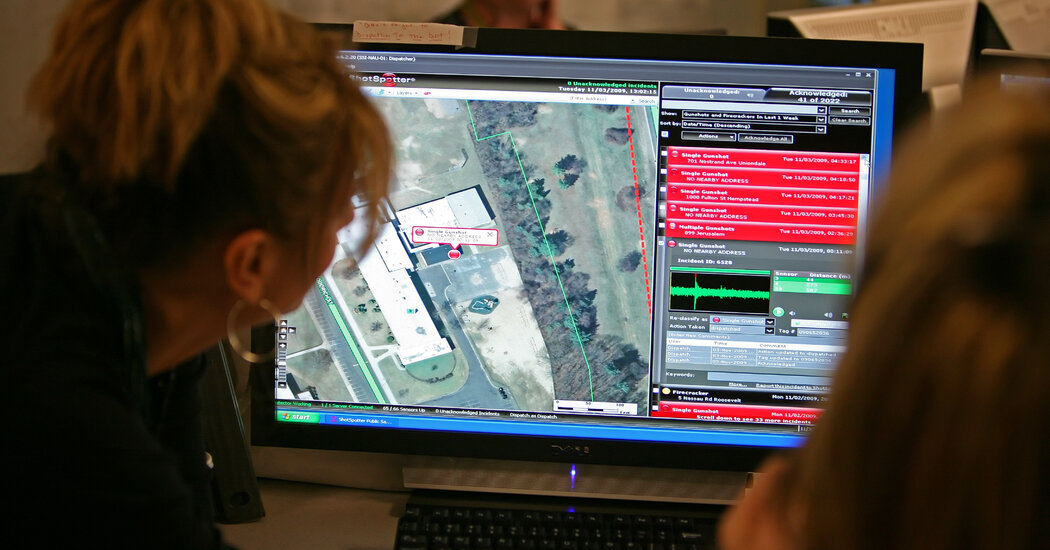ShotSpotter, a system the Police Department uses to detect gunfire, is overwhelmingly inaccurate and leads officers to spend hundreds of hours each month investigating nonexistent shots, according to an audit the New York City comptroller released Thursday.
The Police Department has spent more than $45 million on ShotSpotter since it started using it in 2015, even as cities around the country have stopped using the system. New York must decide before December whether to renew its contract with SoundThinking, the California company that owns the system, and the audit advises officials to decline until the system can be fully evaluated.
Auditors studied ShotSpotter’s accuracy over several months in 2022 and 2023. When it was performing at its best, only 20 percent of ShotSpotter’s alerts actually revealed shootings, they found. Often, it did even worse. Of the 940 alerts officers responded to last June, only 13 percent corresponded to confirmed shootings.
And in 2022, the audit found, the system also failed to detect more than 200 real incidents of gunfire in Manhattan.
The Police Department “is wasting precious time and money on this technology and needs to do a better job managing its resources,” the comptroller, Brad Lander, said in a statement. “Chasing down car backfires and construction noise does not make us safer.”
Several major cities have moved away from ShotSpotter in recent years and others are grappling with whether to renew contracts that will expire this year. Chicago’s mayor campaigned on a promise to jettison the technology and blamed it for the death of an unarmed 13-year old shot by officers responding to an alert in 2021. In Boston, the mayor and police department are on the defensive after three members of the state’s congressional delegation signed a letter that called for a national probe into the system.
The Police Department’s press office declined to comment Thursday, referring to a response to the audit in which the department disputed some aspects of the report, saying that the comptroller’s office classified reports as unfounded if investigators found no physical evidence of gunfire. But that, the department said, did not mean shootings had not happened.
In a statement Thursday, Jerome Filip, a spokesman for SoundThinking, dismissed the audit as a “gravely misinformed in its assessment of data” and said it emphasized the wrong metrics for evaluating the tool.
The company’s shares have lost nearly half their value this year.
ShotSpotter uses sensors that are installed across all five boroughs in New York. The devices listen for sharp, loud sounds and transmit data to staff members who determine whether they sound like gunshots and notify the police. According to SoundThinking’s website, the process should take around a minute.
The audit said that most reports are erroneous, and that officers rarely determined what triggered false alarms. Common culprits are fireworks and street noise, it said. Those false alerts are costly: Officers spent almost 427 hours investigating unconfirmed reports in a single month, the audit found.
The audit suggested that such fruitless work may contribute to the ballooning millions of dollars in overtime that police officers claim each year. The Police Department disputed that, saying that only officers who are already on the clock respond to ShotSpotter alerts.
Civil liberties groups say that the listening devices, which are concentrated in areas where shootings often occur, can lead to overpolicing in low-income neighborhoods that are predominantly home to people of color. The groups also say that prosecutors use the system’s questionable data to construct flimsy cases against people who have been accused of wrongdoing.
Daniel Schwarz, a technology and privacy strategist for the New York Civil Liberties Union, said that he hopes the audit will start a conversation about how the technology is used in New York.
“We know already that these sensors are primarily deployed in communities of color. And we also know from the tragic killing in Chicago of Adam Toledo that ShotSpotter can escalate police violence,” said Mr. Schwarz, adding that “it’s on the N.Y.P.D. to really justify their reasoning behind the technology and why that technology is needed.”
In the department’s response, it said that letting the contract lapse would result in a “less safe working environment for officers and an increased chance of violent encounters for all New Yorkers.”
Maria Cramer contributed reporting.
